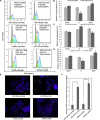MicroRNA-128-3p regulates mitomycin C-induced DNA damage response in lung cancer cells through repressing SPTAN1
- PMID: 28938540
- PMCID: PMC5601636
- DOI: 10.18632/oncotarget.12300
MicroRNA-128-3p regulates mitomycin C-induced DNA damage response in lung cancer cells through repressing SPTAN1
Abstract
The DNA damage response is critical for maintaining genome integrity and preventing damage to DNA due to endogenous and exogenous insults. Mitomycin C (MMC), a potent DNA cross-linker, is used as a chemotherapeutic agent because it causes DNA inter-strand cross-links (DNA ICLs) in cancer cells. While many microRNAs, which may serve as oncogenes or tumor suppressors, are grossly dysregulated in human cancers, little is known about their roles in MMC-treated lung cancer. Here, we report that miR-128-3p can attenuate repair of DNA ICLs by targeting SPTAN1 (αII Sp), resulting in cell cycle arrest and promoting chromosomal aberrations in lung cancer cells treated with MMC. Using computational prediction and experimental validation, SPTAN1 was found to be a conserved target of miR-128-3p. We then found that miR-128-3p caused translational inhibition of SPTAN1, reducing its protein level. SPTAN1 repression via miR-128-3p also induced cell cycle arrest and chromosomal instability. Additionally, miR-128-3p significantly influenced interaction of the αII Sp/FANCA/XPF complex, thus limiting DNA repair. In summary, the results demonstrate that miR-128-3p accelerates cell cycle arrest and chromosomal instability in MMC-treated lung cancer cells by suppressing SPTAN1, and these findings could be applied for adjuvant chemotherapy of lung cancer.
Keywords: DNA repair; MicroRNA; lung cancer; mitomycin C; spectrin.
Conflict of interest statement
CONFLICTS OF INTEREST The authors declare no conflicts of interest.
Figures



Similar articles
-
The Role of Nonerythroid Spectrin αII in Cancer.J Oncol. 2019 May 2;2019:7079604. doi: 10.1155/2019/7079604. eCollection 2019. J Oncol. 2019. PMID: 31186638 Free PMC article. Review.
-
Concordant dysregulation of miR-5p and miR-3p arms of the same precursor microRNA may be a mechanism in inducing cell proliferation and tumorigenesis: a lung cancer study.RNA. 2015 Jun;21(6):1055-65. doi: 10.1261/rna.048132.114. Epub 2015 Apr 7. RNA. 2015. PMID: 25852169 Free PMC article.
-
Downregulation of microRNA-362-3p and microRNA-329 promotes tumor progression in human breast cancer.Cell Death Differ. 2016 Mar;23(3):484-95. doi: 10.1038/cdd.2015.116. Epub 2015 Sep 4. Cell Death Differ. 2016. PMID: 26337669 Free PMC article.
-
MicroRNA-338-3p inhibits cell proliferation in hepatocellular carcinoma by target forkhead box P4 (FOXP4).Int J Clin Exp Pathol. 2015 Jan 1;8(1):337-44. eCollection 2015. Int J Clin Exp Pathol. 2015. PMID: 25755720 Free PMC article.
-
Dme-miR-314-3p modulation in Cr(VI) exposed Drosophila affects DNA damage repair by targeting mus309.J Hazard Mater. 2016 Mar 5;304:360-9. doi: 10.1016/j.jhazmat.2015.10.075. Epub 2015 Nov 10. J Hazard Mater. 2016. PMID: 26590872
Cited by
-
Nanocomplexes loaded with miR-128-3p for enhancing chemotherapy effect of colorectal cancer through dual-targeting silence the activity of PI3K/AKT and MEK/ERK pathway.Drug Deliv. 2020 Dec;27(1):323-333. doi: 10.1080/10717544.2020.1716882. Drug Deliv. 2020. PMID: 32090639 Free PMC article.
-
Targeting on the PI3K/mTOR: a potential treatment strategy for clear cell ovarian carcinoma.Cancer Chemother Pharmacol. 2025 Jan 10;95(1):21. doi: 10.1007/s00280-024-04748-3. Cancer Chemother Pharmacol. 2025. PMID: 39792198 Free PMC article.
-
A Novel Interaction of Slug (SNAI2) and Nuclear Actin.Cells. 2024 Apr 17;13(8):696. doi: 10.3390/cells13080696. Cells. 2024. PMID: 38667311 Free PMC article.
-
Cytoskeletal and Cytoskeleton-Associated Proteins: Key Regulators of Cancer Stem Cell Properties.Pharmaceuticals (Basel). 2022 Nov 8;15(11):1369. doi: 10.3390/ph15111369. Pharmaceuticals (Basel). 2022. PMID: 36355541 Free PMC article. Review.
-
The Role of Nonerythroid Spectrin αII in Cancer.J Oncol. 2019 May 2;2019:7079604. doi: 10.1155/2019/7079604. eCollection 2019. J Oncol. 2019. PMID: 31186638 Free PMC article. Review.
References
-
- Sculier JP, Ghisdal L, Berghmans T, Branle F, Lafitte JJ, Vallot F, Meert AP, Lemaitre F, Steels E, Burniat A, Mascaux C, European Lung Cancer Working P The role of mitomycin in the treatment of non-small cell lung cancer: a systematic review with meta-analysis of the literature. Br J Cancer. 2001;84:1150–1155. - PMC - PubMed
-
- Bakowski MT, Crouch JC. Chemotherapy of non-small cell lung cancer: a reappraisal and a look to the future. Cancer Treat Rev. 1983;10:159–172. - PubMed
-
- Tomasz M, Palom Y. The mitomycin bioreductive antitumor agents: cross-linking and alkylation of DNA as the molecular basis of their activity. Pharmacol Ther. 1997;76:73–87. - PubMed
-
- Palom Y, Suresh Kumar G, Tang LQ, Paz MM, Musser SM, Rockwell S, Tomasz M. Relative toxicities of DNA cross-links and monoadducts: new insights from studies of decarbamoyl mitomycin C and mitomycin. C. Chem Res Toxicol. 2002;15:1398–1406. - PubMed
-
- Pasquinelli AE. MicroRNAs and their targets: recognition, regulation and an emerging reciprocal relationship. Nat Rev Genet. 2012;13:271–282. - PubMed
LinkOut - more resources
Full Text Sources
Other Literature Sources
Miscellaneous

